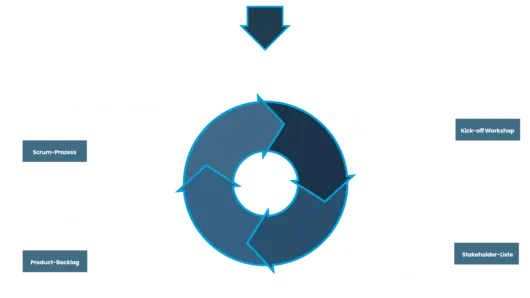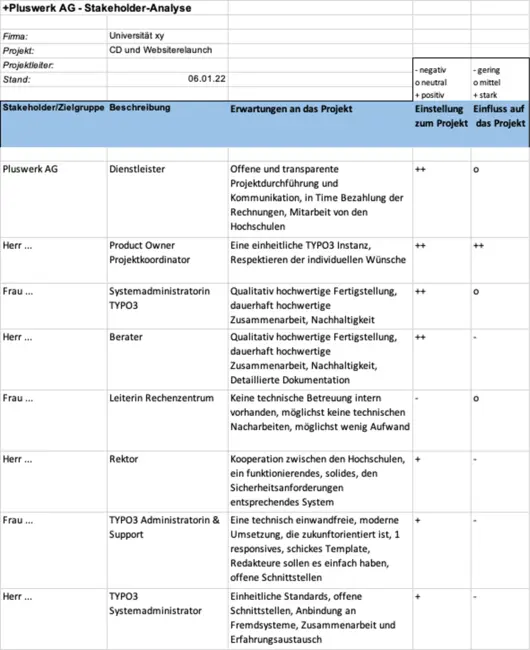Stakeholder management is one of the most important tasks of project management and requirements analysis.
Identify, analyse and communicate, these are the three tasks when companies deal with stakeholders.
In the agile environment, stakeholder management is a primary task of the product owner to ensure the achievement of objectives and the satisfaction of clients and users. The product owners can be assisted by experts (e.g. UX designers, community managers, SEO specialists).
If the stakeholders are ignored, this can lead to undesirable developments and acceptance problems in projects.
Stakeholder management is an comprehensive process which needs to be paid attention during the whole project. Equally, the stakeholder structure should be reviewed on an ongoing basis and the process repeated if necessary, as stakeholders can change.
(1.) Stakeholder identification and (2.) Stakeholder analysis
Establish the stakeholder list in a workshop (alternatively individual interviews) with as many possible stakeholders as possible:
- Who is the stakeholder (position in the company)?
- What are his expectations for the project?
- What is his attitude to the project?
- What is his influence on the project?
Once the stakeholder list has been completed, a force field diagram can be drawn up to illustrate the influence, from which subsequent measures for stakeholder engagement can be derived.
Example of a stakeholder list (excerpt):
Focus Groups
Especially in the university environment, we have had very good experiences with the establishment of focus groups in order to pick up on different, sometimes non-homogeneous stakeholder groups and to be able to take on board their wishes and feedback.
Focus groups can be, for example, people from target groups (administration, students, professors), faculty representatives, marketing staff or university IT staff.
These Focus Groups can sharpen the view of the project from a particular angle and have a workshop character.
Practicable for stakeholder groups of 5-20 people per group
Presentations with a feedback round
Especially after conducting focus circles, but also after completing project phases (e.g. creation of wireframes, design phase, conception of a complex feature, provision of an MVP), very large stakeholder groups can be specifically addressed through presentations.
Here, visual presentations with compressed information are increasingly offered, since entry at a detailed level is difficult in this context and, from our experience, can be detrimental. The information content must be understandable and relevant for a large part of the round.
In particular, the presentation of design concepts usually triggers a wide range of opinions in the stakeholder circle, and we use our extensive experience to provide helpful advice to the Uni-PO (University - Product Owner) on how to deal with these.
The filtering and classification of diverse feedback in the follow-up usually reveals a wide variety of opinions, with the weighting of feedback being carried out by the PO team alone. Priorities for further requirements or changes are derived from this.
Practicable for stakeholder groups of 10-100 people
Open Reviews
Already integrated into the SCRUM sprint structure is the so-called review meeting, in which the development team presents the results of the current sprint (development cycle). It is not only sensible, but also strongly recommended to involve all stakeholders who will work with the results or have helped to shape them as a requirement.
It should be noted that no new specifications or changes are dealt with in this framework, but only a presentation and information is provided to the stakeholders involved.
Practicable for stakeholder groups of 1-5 people.



